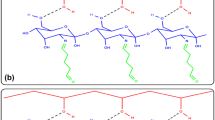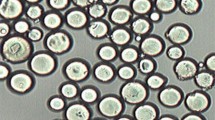Abstract
Urease was immobilized onto gelatin-poly (HEMA) copolymer by covalent linkage. Maximum amount of urease was immobilized onto the support at a pH of 8.5. The optimal pH of the immobilized urease was similar to that of free urease; the optimal temperature showed an increase of 10 °C over the free enzyme. The stability of the immobilized urease for a range of pH, temperature and shelf life was greater than the corresponding values for the free enzyme. The same result was obtained for k m also.
Similar content being viewed by others
References
Alvesda Silva, M.; Gill, M. H.: Graft copolymers as supports for the immobilization of biological compounds: In: Guilbault, G. G.; Mascini. M. (Eds): Analytical uses of immobilized biological compounds for detection, medical and industrial uses, pp. 177–185, D. Reidel Publishing Co
Kennedy, J. F.: Immobilized enzymes: In: Scouten, W. H. (Ed.): solid phase Biochemistry, pp. 265–273. New York: J. Wiley & Sons 1983
Chellapandian, M.; Sastry, C. A.: Immobilization of alkaline protease on nylon. Biopro. Eng. 11 (1994) 17–21
Hayashi, T.; Ikoda, Y.: Lipoprotein lipase immobilization onto polyacrolein microspheres. Biotechnol. Bioeng. 36 (1990) 593–6000
Raghunath, K.; Panduranga Rao, K.; Thomas Joseph, K.: Preparation and characterization of urease immobilized onto collagen-poly (Glycidyl Methacrylate) graft copolymer. Biotechnol. Bioeng. 26 (1984) 104–109
Krajewska, B.; Zaborska, W.: Dialysate regeneration system of artificial kidney. Biocyb. Biomed. Eng. 9 (1989) 113–129
Stanislaw, G.; Robert, K.; Ewa, K.; Izabela, W.; Adam, H.: Urea sensors based on PVC membrane pH electrode. Talanta 41 (1994) 1201–1205
Lowry, O. H.; Rosebrough, N. J.; Farr, A. L.; Randall, R. J.: Protein measurement with the Folin-phenol reagent. J. Biol. Chem. 193 (1951) 265–275
Zaborsky, O.: Properties of covalently bonded water-insoluble enzyme-polymer conjugates. In: Immobilized Enzymes, pp 49–50, Cleaveland, Ohio: C.R.C. Press 1974
Petach, H. H.; Driscoll, J.: Transparent chitosan derivatives for the immobilization of glutamate dehydrogenase. Biotechnol. Bioeng. 44 (1994) 1018–1022
Krajewska, B.; Leszko, M.; Zaborska, W.: Urease immobilized on chitosan membrane: Preparation and properties. J. Chem. Tech. Biotechnol. 48 (1990) 337–350
Author information
Authors and Affiliations
Additional information
Grateful acknowledgement is made to CSIR, Govt. of India for the research associateship conferred on Dr. M. Chellapandian which helped the progress of this piece of research investigation.
Rights and permissions
About this article
Cite this article
Srinivasa Rao, M., Chellapandian, M. & Krishnan, M.R.V. Immobilization of urease on gelatin — poly (HEMA) copolymer preparation and characterization. Bioprocess Engineering 13, 211–214 (1995). https://doi.org/10.1007/BF00367256
Received:
Issue Date:
DOI: https://doi.org/10.1007/BF00367256




